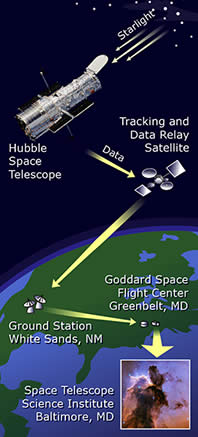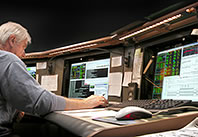
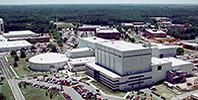
Goddard Space Flight Center is home to the Space Telescope Operations Control Center for Hubble.
Gathering images from space is more than a "point and shoot" proposition. The Hubble Space Telescope explores our universe 24 hours a day, 365 days a year. Operating and maintaining such a tireless observatory and converting its raw data (digital signals) into images requires considerable effort from the people on the ground.
Operating Hubble
Hundreds of scientists, engineers, and technicians — at both NASA's Goddard Space Flight Center and the Space Telescope Science Institute (STScI) — bear the collective responsibility for operating the Hubble Space Telescope and for monitoring its health, safety, and performance. Specific tasks range from choosing targets to performing on-orbit upgrades.
Hubble mission operations fall into two categories:
Engineering operations, which test and maintain the Hubble spacecraft's overall performance.
Science operations, which select and schedule observing programs, prepare and conduct observations, calibrate the science instruments, translate raw data into usable form, and archive and distribute data.
Hubble's Ground Control
Flight Operations
- Establish the status of systems (mechanical, electrical, and data management) and subsystems
- Look for unusual things in Hubble's behavior
- Route commands generated onboard or received from the ground
- Manage communications
All of the Hubble Space Telescope's activities are controlled by people on the ground. The focal point of all Hubble operations is the Flight Operations Team (FOT), which is located at the Goddard Space Flight Center in Greenbelt, Maryland. Here, Hubble's controllers monitor the telescope's health while overseeing its movements and science activities. The controllers direct Hubble's movements by sending commands via satellite to the telescope's onboard computer. The majority of Hubble's operations are programmed in advance, but controllers can also interact in real time with the spacecraft, telling it what to do and when to do it.
Hubble's flight operations facility operates 24 hours a day, 7 days a week. The specially trained engineers and technicians who comprise the FOT work rotating shifts, with 3 to 4 people on each shift. A typical day involves commanding and pointing the telescope, monitoring its behavior on consoles, and looking for anything unusual in the technical sense.
The ground controllers become even busier than usual during Hubble servicing missions. Shortly after the shuttle is launched, the controllers instruct Hubble to stop normal science operations. To prepare the huge telescope for rendezvous and capture, they command Hubble's aperture door to close and its high gain antennas to be stowed. After capture, as the astronauts install new equipment on Hubble, the controllers immediately test the updates. Later, while the crew sleeps, controllers perform more detailed reviews. At the end of each servicing mission, the Flight Operations Team deploy Hubble's high-gain antennas and open its aperture door. They then reactivate all Hubble equipment powered off during the servicing call.
After that, the telescope undergoes a check-out period, called the Servicing Mission Orbital Verification (SMOV), during which all new instruments are put through their paces to ensure that everything is operating as expected.
Competing for Hubble Time


STScI employees review the observation schedule.
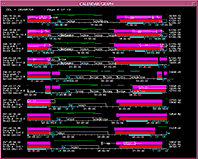 A miniscule portion of Hubble's observations schedule Enlarge graphic
A miniscule portion of Hubble's observations schedule Enlarge graphic
Each year astronomers from dozens of countries vie for precious minutes of Hubble's unrivaled view of the cosmos. Astronomers from around the world submit observing proposals to the Space Telescope Science Institute (STScI).
A review committee made up of experts from the astronomical community determines which proposed observations address pressing scientific questions and make the best use of the telescope's capabilities. Each year more than 1,000 proposals are reviewed and approximately 200 are selected, which represents roughly 20,000 individual observations.
Scheduling of the viewing time falls to staff at STScI. Once a proposal is accepted, the observation is carefully planned — along with thousands of others — for the most appropriate viewing time. Planning viewing time is tricky because there are certain times of the year during which Earth's revolution around the Sun causes a "geometry" in which the target is too close to the Sun to be observable.
Consequently, technicians must schedule each observation down to a fraction of a second. Observation information such as which instrument to use, what filter to use, and how long the exposure should be must be converted into a detailed technical list of second-by-second instructions. These instructions are loaded onto the telescope's computers a few days before the scheduled observation.
Observing with Hubble
Imagine trying to take a picture of someone from a seat on a moving Ferris wheel. You'd have a hard time keeping that person in the camera's field of view. Astronomers using Hubble have to take this concept to the extreme. Their "camera" is revolving around Earth at 17,500 mph (28,200 kph)... and Earth is moving around the Sun at 67,000 mph (107,800 kph). First they must pinpoint a tiny target's exact location in the vast sky... and then keep the object within the telescope's field of view.
To do this, a pair of "guide stars" are selected whose apparent positions are near the science target. The guide stars are selected from the Space Telescope Science Institute's Guide Star Catalog, which lists the brightness and positions of 200 million stars. These guide stars help center the target in the telescope's field of view.
Guide star information is combined with the detailed observation instructions and transmitted to Hubble's onboard computers via satellite. The telescope's computers send the data to the Fine Guidance Sensors (FGS), which search for the guide stars — "lock on" to them — and maintain the precise pointing and alignment needed for a Hubble observation.
The images and data that Hubble gathers during an observation are stored on an onboard data recorder. Information from the data recorder is transmitted back to Earth several times a day.
Data Management
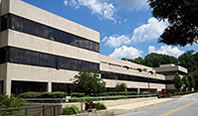
Hubble data is sent to the Space Telescope Science Institute, Baltimore, MD.
The raw data collected by the telescope have a long way to go before they become actual Hubble images. As Hubble completes a particular observation, it converts the starlight into digital signals. The digital signals are then relayed down to a ground station at White Sands, New Mexico through two orbiting Tracking and Data Relay Satellites (TDRS). The ground station then relays the data to Goddard Space Flight Center's ground control system, where staff ensure its completeness and accuracy.
Goddard then sends the data via data lines to the Space Telescope Science Institute for processing and calibration. Institute personnel translate the data into scientifically meaningful units — such as wavelength or brightness — and archive the information on 5.25-inch (13.3-cm) magneto-optical disks. Hubble sends the archive enough information to fill about 18 DVDs every week. Astronomers can download archived data via the Internet and analyze it from anywhere in the world.
NEXT: Servicing Missions
